How Tim Cain's hatred of white chocolate made it into The Outer Worlds as an Easter egg
The dev team hid a white chocolate bar in the game—and 17 real ones in Tim Cain's office. He hasn't found them all yet.
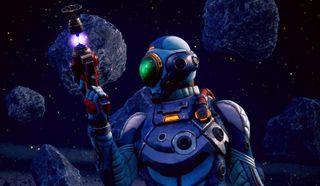
The next time I tell someone I love chocolate, a voice in the back of my head will be calling me a liar. Love? It'll say. You only like chocolate. Tim Cain? Tim Cain loves chocolate. I talked to the co-director of The Outer Worlds a week after its successful launch, eager to ask what was next, but first we ended up talking about chocolate.
It ties back into The Outer Worlds, though. I promise.
"We usually have chocolate meetings now," he says as soon as we start talking. "Every day at 2:30, I send out on a chocolate Slack channel that I have new chocolate. We had enough bandwidth it deserved its own channel. I usually send out the [details]: If it's single origin, what country it's from, the cacao percentage, any flavoring agents. We all eat a piece and we talk about it and then I blog it, and so that way I have a list of everything chocolate I've eaten since 1993 and whether I liked it."
That's a cool 26 years of dedicated chocolate logging, which means that since well before he made Fallout, Tim Cain has been refining his cacoa palate. With development wrapped, The Outer Worlds may not need daily chocolate meetings anymore, but the team at Obsidian still managed to immortalize this particular idiosyncrasy in the game itself. Like the best Easter eggs, this one only means something when you learn a little bit about the people behind it.
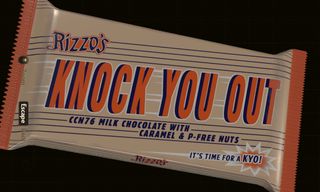
"We have our own chocolate variant called CCN 76" in The Outer Worlds, Cain says. "Right before we certed the base game, I caught my lead designer—he tried to sneak in 'Tim Cain's White Chocolate Yummies' and I found it, because it was a piece of text."
Important Tim Cain fact: He loves chocolate, but white chocolate? Nah. Mostly trash, though he admits he's had a few good ones in 26 years. Back to the Easter Egg."So I found the thing and I deleted it all. Unbeknownst to me, and I discovered this after we certed, he went to an artist and had them write that into the art. So you can't search for it and it's on a character that you were highly unlikely to kill. But he didn't know I was playing a game where I was killing everybody, because I wanted to make sure you could do that and it's fun. I killed that person and [saw it] and then I went to his office but it was too late, we had already certed. So it's in the game."
They got him.
The biggest gaming news, reviews and hardware deals
Keep up to date with the most important stories and the best deals, as picked by the PC Gamer team.
I've hidden 17 bars of white chocolate in your room. Have fun.
-Ransom note on Tim Cain's desk
It doesn't seem like an exaggeration to say that chocolate played an important role in The Outer Worlds' development. In the town of Roseway, there's a bar called the 17th Bar, and it, too, is the result of a complex prank on Tim Cain.
"Somebody, about halfway through development, hid 17 white chocolate bars in my office," Cain says. "There was a note on my desk made of cutout letters. They put a lot of time into this. It looked like a ransom note and said, 'I've hidden 17 bars of white chocolate in your room. Have fun.' Knowing I hate it.
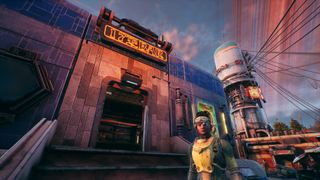
"I looked everywhere. The first day I could only find 13. Over the next week, week and a half, I found another three. I never found the 17th one. So then Tyson, the level designer, he was sitting next door. He put a bar in Roseway called The 17th Bar, that you can go and get drinks at. When you walk in, it's got that big flickering light and he says, "I just wanted you to remember the 17th bar." So talk about an Easter egg that doesn't mean anything, except to people who were here at Obsidian working on this project."
Cain and his co-director Leonard Boyarsky knew what they had to live up to with The Outer Worlds, shipping an Obsidian RPG—especially since they created Fallout, and Obsidian hadn't made a game in this style since 2010's New Vegas. Before they even had concept artists, they'd written more than 100 pages of worldbuilding material, defining voice and technology and corporations down to specific word choices: Robots have circuit boards, but they don't have chips.
"We got really picky like that. For me, I want to know that 10 years from now, when I'm probably not working on this, that it's still the game I imagined," he says. "Plus, I saw Fallout going in a different direction. No fault of their own—we didn't leave a lot of notes around. So as people started working on it, they had to play the game and go, 'I think this is what they meant...'"
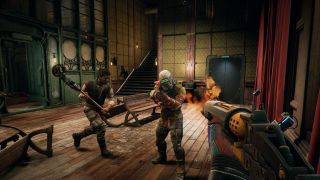
They did their best to cross every T and dot every I, but what ended up being most surprising about The Outer Worlds was its painless launch. That's the other thing Obsidian's games in this style, like New Vegas and Knights of the Old Republic 2, are known for: Being a bit buggy.
Cain says they were prepared to crunch after release, fixing crashes and issues players ran into. But it was so smooth, they've been able to take a breather and take some time before the first patch, which should be out soon, and respond to some more substantial feedback.
"Somebody found a place that it consistently crashed, but just on one platform, and then there's been another bug where sometimes companions get in a bad state in your ship," Cain says. "But for the most part the things we're fixing are things people have asked for, like larger fonts."
Another quality of life issue he intends to fix is that vending machines don't show how much you're carrying, which makes selling items while over-encumbered a tedious process. There's also difficulty, which came as a surprise: Many players have asked for a harder setting that doesn't come with the restrictions of the Supernova difficulty. He's got a list of UI things to address, and hopes to put out a second update around Christmas, once more player feedback comes in. But when we spoke, it was definitely time for a well-earned victory lap.
I asked Cain about the creation of one of our favorite characters in The Outer Worlds, the robot SAM. The idea for SAM, a no-personality no-illusions-of-humanity plain' ol robot, was to build a companion for players who wanted to play without the "peskiness" of companions having their own sidequests, but with some of their advantages.
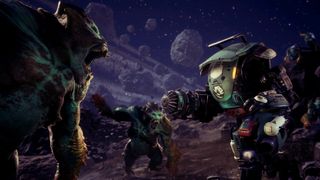
Writer Megan Starks took on Sam, and Cain told her: "It's not sentient. But it's programmed to be upbeat, trying to be helpful. It seems everything through the lens of its programming, which is, 'I clean things."
"She wrote some really awesome stuff, Cain says. It says things sometimes that you're like, is it being meta? It's saying something just about cleaning but it's actually sometimes social commentary, too. We had originally thought he was going to be more robotic and it was Megan who said, 'I think it should sound like they recorded a salesman at the factory, who was super excited like, 'Oh my God, I get to be the voice of a robot.'"
So far The Outer Worlds seems to be the kind of success story that makes you wonder why Obsidian hadn't made a game in this style for so long. According to Cain, it wasn't for lack of wanting—it's just been hard to get them made.
But I can tell you three years ago, not a lot of people were interested in this style of game
Tim Cain
"This is the form of a game I love to play," he says. "It's not necessarily open world, because we get tighter control over what kind of narrative we tell. Hub and spoke, is what a lot of people call it. First-person gives us a cool immersion. I know Leonard mentioned once years ago that we had already planned to take Fallout first person after Fallout 2.
"I don't know why a lot of publishers think nobody wants to play this. Part of the reason Obsidian hasn't done it, is because publishers didn't want them. Now Microsoft, I think, is going to keep making stuff in this vein, because this looks so popular. But I can tell you three years ago, not a lot of people were interested in this style of game and Private Division took a chance, and they were really good."
For now, he's got a few months of work ahead to take feedback on The Outer Worlds and prepare that second patch. After that? Well, nothing's official, but it sounds like there's more Space Capitalism ahead.
"I want people to play for awhile and then see what the friction points are and see if there are bugs we missed, put out something before or after Christmas and then think about sequel," says Cain with perhaps just a bit of a twinkle in his eye. "I don't think we're probably going to talk about that. But I'm thinking about it."

Wes has been covering games and hardware for more than 10 years, first at tech sites like The Wirecutter and Tested before joining the PC Gamer team in 2014. Wes plays a little bit of everything, but he'll always jump at the chance to cover emulation and Japanese games.
When he's not obsessively optimizing and re-optimizing a tangle of conveyor belts in Satisfactory (it's really becoming a problem), he's probably playing a 20-year-old Final Fantasy or some opaque ASCII roguelike. With a focus on writing and editing features, he seeks out personal stories and in-depth histories from the corners of PC gaming and its niche communities. 50% pizza by volume (deep dish, to be specific).
Most Popular

